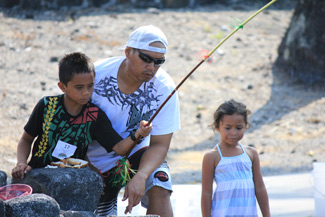 Dayhtan Barawis drops his line into Waikua‘a‘ala Pond in Kahalu‘u Bay Education Center’s first-ever Keiki Fishing Derby. He went on to win prizes for Most Fish Caught and Biggest Fish Caught in the Boys 7-10 division.
Dayhtan Barawis drops his line into Waikua‘a‘ala Pond in Kahalu‘u Bay Education Center’s first-ever Keiki Fishing Derby. He went on to win prizes for Most Fish Caught and Biggest Fish Caught in the Boys 7-10 division.More than 50 keiki (children) ages 7 to 15 participated in the free event, held at Waikua‘a‘ala Pond at Kahalu‘u Beach Park. Once a royal bath for ali‘i (Hawaiian chiefs), the historic pond was severely damaged by a tsunami that hit Hawai‘i Island’s leeward coast in April 2011. Restoration of the pond, a labor-intensive and costly endeavor, seemed an impossible task until Cindi Punihaole, Kahalu‘u Bay Education Center program director, ran a small ad in the newspaper asking for volunteers. More than one hundred island residents responded, rebuilding the pond over a series of long Saturdays and working with the advice and assistance of Hawaiian cultural masons. By August 2011, restoration was nearly complete except for one “tiny” problem: hundreds of four-to-five-inch tilapia that had taken up residence in the pond.
“The Keiki Fishing Derby was primarily designed to help remove the invasive tilapia living in the pond,” Punihaole said, “but it was also meant to teach our keiki how to fish and ensure that ancestral knowledge carries forward when we are no longer here to take care of them. Like the proverb says, ‘Give a man a fish and you feed him for a day; teach a man to fish and you feed him for a lifetime.’”
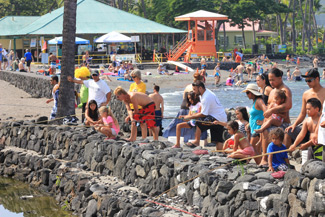 More than 50 keiki and their families turned out for a beautiful day of fun, fishing, Hawaiian games and music, and environmental stewardship.
More than 50 keiki and their families turned out for a beautiful day of fun, fishing, Hawaiian games and music, and environmental stewardship.Nine-year-old Sidney Stephens pulled in a five-inch-plus tilapia. The fish was his first and the Derby was his first time fishing. With satisfaction visibly evident on his face, Sidney paused briefly to pose for a picture but didn’t celebrate long, knowing that in this contest, winning was based on number of fish caught as well as size. And seven-year-old Victoria Lindersmith fished with a pole she had decorated with ocean-themed stickers that sparkled in the sunlight. Victoria came to the Derby with her parents and grandmother, all of whom cheered loudly when she pulled up one last fish at the buzzer. They were to cheer again later in the day when Victoria won a prize for Best Fishing Pole.
Collectively, the children hooked 373 tilapia, which were all turned over to Kona Aquaponics, where waste from the fish will be used as fertilizer for vegetables sold in Hawai‘i Island markets and the fish themselves raised for food. Happy to serve as an event sponsor based on his love for Kahalu‘u Bay, Kona Aquaponics owner Daniel Kauth supplied buckets and nets, as well as prizes for the Derby.
In addition to the Fishing Derby, the day was filled with fun and cultural activities for the entire ‘ohana (family), including lauhala and coconut-frond weaving, Hawaiian games and live music, face painting, and a visit from Hoagus Boagus Da Clown. The event provided families with the opportunity to reconnect with Kahalu‘u Bay and Beach Park, bond with each other, and learn about protecting the island’s natural resources.
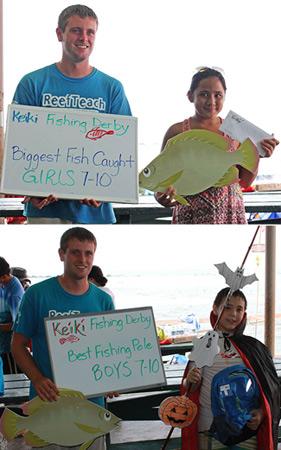 Derby winners receive their prizes from Matt Connelly of Kahalu‘u Bay Education Center. Kasey Barawis (top) caught the Biggest Tilapia in the Girls 7-10 division and Tye Galigo (bottom) took the award for Best Fishing Pole in the Boys 7-10 division.
Derby winners receive their prizes from Matt Connelly of Kahalu‘u Bay Education Center. Kasey Barawis (top) caught the Biggest Tilapia in the Girls 7-10 division and Tye Galigo (bottom) took the award for Best Fishing Pole in the Boys 7-10 division.“For me, it was a success. We rid the pond of so many fish!” Sakata said. “I hope we continue to hold this tournament every year.”
The winners in each category were:
Best Fishing Pole
Boys 7-10: Tye Galigo
Girls 7-10: Victoria Lindersmith
Boys 11-15 (tie): Aidan and Gavin Lewis
Girls 11-15: Zea Levine
Most Tilapia Caught
Boys 7-10: Dayhtan Barawis, 53 fish
Girls 7-10: Kasey Barawis , 35 fish
Boys 11-15: Siprs Kaawa, 24 fish
Girls 11-15: Taylie Oshiro, 5 fish
Biggest Tilapia Caught
Boys 7-10: Dayhtan Barawis, 6″
Girls 7-10: Kasey Barawis , 6 1/4″
Boys 11-15: Henry Cho IV, 6 1/2″
Girls 11-15: Taylie Oshiro, 5 3/4″
The Derby’s success would not have been possible without the support of community sponsors and volunteers. “Our supporters are treasures and we love them,” Punihaole said. Sponsors included Fair Wind Cruises, Patagonia, Jack’s Diving Locker, Kona Aquaponics, and Body Glove, which all donated prizes. Young Brothers provided a $1,000 grant in support of the event, and KTA Superstores and Starbucks donated food and drinks for volunteers. Radio stations B93 and B97 FM and KWXX-FM donated public service announcements.
Sustenance at sea: Connecting school gardens with Mālama Honua
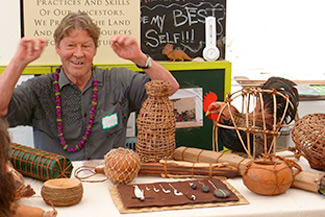 Gary Eoff demonstrates the Hawaiian art of cordage and packaging at November’s ‘Aipono Workshop.
Gary Eoff demonstrates the Hawaiian art of cordage and packaging at November’s ‘Aipono Workshop.Sponsored by The Kohala Center’s Hawai‘i Island School Garden Network (HISGN), the ‘Aipono Workshop, held November 16th at Māla‘ai: The Culinary Garden of Waimea Middle School, gave participants the opportunity to learn about foods used in past voyages, and about the current challenges organizers face as the Hōkūle‘a and Hikianalia crews train and provision the wa‘a (canoes) for the first leg of their ‘round-the-world voyage.
‘Aipono Workshop presenters—dietitian Ka‘iulani Odom, navigator Chadd Paishon, and voyagers Kealoha Hoe and Pomai Bertelmann—shared stories, family recipes, and canoe cooking ideas with school garden teachers and volunteers, who will in turn engage students and connect school garden curriculum to the Mālama Honua voyage. As part of the food demonstration, the presenters shared herbs, spices, fermented vegetables, and dried fruits that can make meals more flavorful and digestible at sea. They also prepared lunch to give workshop participants a taste of a meal aboard the wa‘a, including one of Kealoha Hoe’s comfort dishes, tofu hekka.
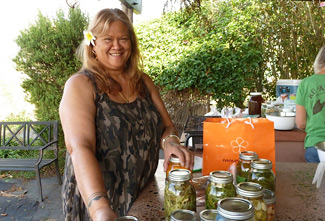 Kaiulani Odom shows off an assortment of pickled vegetables carried and used on wayfinding voyages.
Kaiulani Odom shows off an assortment of pickled vegetables carried and used on wayfinding voyages.HISGN Director Nancy Redfeather hopes school garden students and teachers will create recipes and grow food that could actually be used on board the voyaging vessels. She also is enthusiastic about the educational lessons related to sustainability.
“It’s a real educational opportunity for us to not only follow the voyage and connect to the people, places, and foods of all the countries they’re going to visit, but also to experiment with the foods of this place,” Redfeather said. “How can we help our wa‘a crew to eat sustainably when they’re on board? Because this is the message that they’re carrying—of sustainability—how can we become more sustainable in our food, water, energy, and waste?
“To be a good example of what the Mālama Honua project is all about, we want to help in some way. We hope that when the Makali‘i leaves in March of 2015 to travel south to connect with Hōkūle‘a and Hikianalia in Tahiti, a lot of the foods on that voyage—thirty days down and thirty days back—will come from school gardens.”
 Participants were treated to a lunch made up of several dishes often made on wa‘a voyages, including Kealoha Hoe’s tofu hekka.
Participants were treated to a lunch made up of several dishes often made on wa‘a voyages, including Kealoha Hoe’s tofu hekka.To learn more about Mālama Honua: The Worldwide Voyage of the Hōkūle‘a and Hikianalia, please visit hokulea.org/world-wide-voyage.
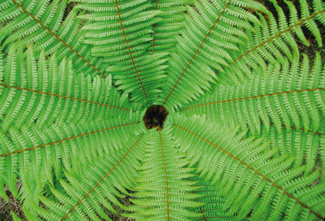 Legacy planning provides donors with options to support their favorite organizations and causes well into the future. Photo by Jack Jeffrey.
Legacy planning provides donors with options to support their favorite organizations and causes well into the future. Photo by Jack Jeffrey.When many donors consider making a contribution they opt to volunteer time, share a skill, or donate cash that can be used immediately. Though these are all essential forms of support that help to achieve goals, legacy gifts make a difference far longer into the future—often in perpetuity—ensuring that important programs will continue.
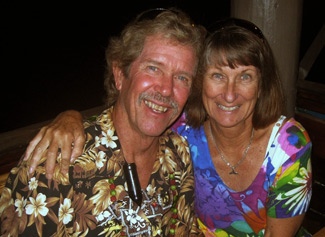 Bo and Jamie Pardau have been avid supporters of Kahalu‘u Bay Education Center and ReefTeach for years. Through careful estate planning, their legacy of support will continue for years to come.
Bo and Jamie Pardau have been avid supporters of Kahalu‘u Bay Education Center and ReefTeach for years. Through careful estate planning, their legacy of support will continue for years to come.A bequest made through a will or estate plan is the most common way of structuring a legacy gift. For the Pardaus, the decision was easy. “Moving to Hawai‘i was really a dream come true for us,” says Jamie. “Our hearts are on this island. Bo and I feel that our legacy—what we want to benefit after we are gone—needs to be right here on this island.”
Bo and Jamie are divers who have enjoyed Kahalu‘u Bay for many years—first as visitors, then as full-time residents. Bo is also an underwater photographer. They moved to Hawai‘i Island almost ten years ago from northern California to transition into semi-retirement.
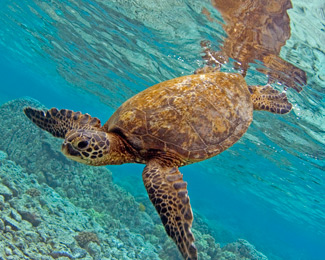 A photo of a honu (green sea turtle) at Kahalu‘u Bay taken by Bo Pardau.
A photo of a honu (green sea turtle) at Kahalu‘u Bay taken by Bo Pardau.Over the years, Jamie has seen ReefTeach make a visible difference, which in turn inspires her and Bo to support The Kohala Center beyond their lifetimes. “When I joined ReefTeach it felt like I was doing important work,” she says. “Now I am absolutely thrilled when people come up and say that they’ve been coming to visit for years and comment on how much better the bay looks. When we saw the Conceptual Master Plan for Kahalu‘u Beach Park, and we looked at what we wanted to contribute to after we are gone … that was it.”
Click here to learn more about charitable giving options that will ensure The Kohala Center and its programs will continue to serve island communities well into the future. If you are interested in making a legacy gift, please contact Executive Director Matt Hamabata at The Kohala Center at 808-887-6411.
 Cauliflower coral in waters off Puakō. The ReefTeach program at Kahalu‘u Bay is being replicated at Puakō in an effort to educate beachgoers in ways to protect fragile coral reefs and marine life.
Cauliflower coral in waters off Puakō. The ReefTeach program at Kahalu‘u Bay is being replicated at Puakō in an effort to educate beachgoers in ways to protect fragile coral reefs and marine life.With over 400,000 visitors annually, Kahalu‘u Bay’s corals, marine life, and water quality are susceptible to damage from human use. For years, swimmers and snorkelers were unknowingly trampling the bay’s fragile corals to death. Founded in 2000, the ReefTeach program deploys volunteers on the beach and in the water to educate roughly 50,000 of these visitors each year on how best to enjoy the bay without harming the bay’s reefs, fish, and endangered honu (green sea turtles).
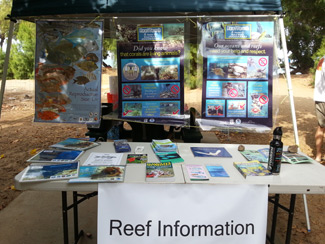 ReefTeach information booth set up at Waialea Bay.
ReefTeach information booth set up at Waialea Bay.“We had been running a Makai Watch booth in Puakō for a couple of years, and wanted to increase our volunteers to reach more people,” said Fry. “We are big believers in education, and Kahalu‘u Bay’s ReefTeach certainly has it down pat. We thought ReefTeach would be a perfect fit for our community.”
Much like Kahalu‘u Bay, Puakō is home to many honu, and also offers excellent fishing waters, seasonal surf spots, and picturesque snorkeling and diving. Many of Puakō’s beach-goers to are residents who use the area for everything from paddle boarding to picnics, and spear fishing to surfing.
“When the folks at Puakō Community Association came to us because they saw what we were doing at Kahalu‘u, we thought it was really great,” said Connelly. Adding that most visitors to Waialea Bay make a “beeline for the beach” and don’t want to talk to volunteers at a booth,
Connelly noted that Fry and Hayward “asked us to help train their volunteers on how to stroll on the beach and talk to people about caring for the ocean and sea life.”
 Beachgoers at Waialea Bay.
Beachgoers at Waialea Bay.“We are working to tailor ReefTeach to Puakō,” Fry said. “Our goal is to help people understand how to protect our area as well as help people identify the fish they see.” ReefTeach has proven to be effective at Kahalu‘u Bay, with observational data indicating that educated visitors make concerted efforts not to stand on the reefs and keep a healthy distance from turtles. Some visitors who have been coming to the bay for years report noticing corals regenerating and an increase in fish. The dedicated residents of Puakō hope to replicate the same successes at their beaches as well.
With the assistance of The Kohala Center, the PCA board secured a grant through the National Oceanic and Atmospheric Administration (NOAA) designed to recruit additional volunteers, create educational materials, and provide qualified trainers at both Waialea Bay and Paniau Cove. In addition, Fry said they’ve been able to hire a full-time ranger through the Department of Land and Natural Resources.
“The ReefTeach program is very professional, and both Matt (Connelly) and Cindi (Punihaole) have been instrumental in designing a training program and creating materials to educate visitors on the beach,” said Clarke. “These tools enable us to be effective in talking to folks about ocean marine resources.”
Punihaole said an online portal is being created so that Clarke and volunteers will be able to enter qualitative and quantitative data and information collected at Puakō’s beaches. “They will be able to report on fishermen’s activities and how visitors behave at the beaches, which will help them chart trends and better understand what’s happening in their area,” she said.
Both Fry and Clarke are confident that the ReefTeach program will make a big difference in how visitors view and treat their surroundings, both at Puakō and beyond.
“We’re really happy to partner with The Kohala Center and Kahalu‘u Bay Educational Center,” Clarke said.
PCA continues to recruit volunteers for its ReefTeach program, with the next training scheduled for Friday, January 17, 2014 at 6 p.m. at the Hokuloa Church in Puakō. For more information and to register, please contact Ranger Randy Clarke at 808-345-1345.
Pilina: The Hawai‘i Island Conservation Forum 2013
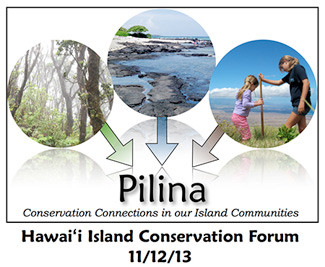 Pilina brought together 200 conservation professionals from around Hawai‘i Island for a day of presentations, discussions, ideas, and unity.
Pilina brought together 200 conservation professionals from around Hawai‘i Island for a day of presentations, discussions, ideas, and unity.The Hawai‘i Island Conservation Forum—coordinated by the Kohala Watershed Partnership (KWP), a sponsored program of The Kohala Center—brought island conservation professionals together to identify synergies, highlight existing partnerships, and create a collaborative network for future projects.
Representing neighborhoods and ecosystems across the island—from Kohala to Ka‘ū, from Puna to Kona, from summit to sea—the 200 participants in the Forum heard from each other about the work being done to protect and nurture the land, the water, the forests, the reefs, and the people of Hawaiʻi Island.
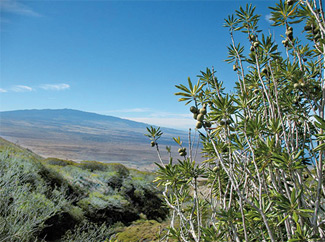
• Environmental science field programs through KWP for middle school students from Waikoloa School;
• Native Hawaiian families deepening their connections to the land and sharing their stories
• Cooperative efforts between neighborhoods and the Big Island Invasive Species Committee to control damaging albizia trees in Hilo;
• Community and volunteer efforts to revive anchialine pond ecosystems in Ka‘ū;
• Forest restoration projects on Mauna Kea involving community volunteers and students; and
• Partnership between Kamehameha Schools, Hawai‘i Volcanoes National Park and the state Division of Forestry and Wildlife to protect native ecosystems on the slopes of Mauna Loa.
“It was great to meet so many others in our field, to be able to discuss techniques and methods, learn from each other’s successes and failures, and discover opportunities to work together,” said Cody Dwight, KWP field operations technician. “I got recharged after Pilina knowing that we’re not alone in our conservation work, that there are efforts going on all over the island driven by literally hundreds of colleagues. It was a rare opportunity for all of us to connect the dots, and connect with each other.”
At the end of the event, an open discussion allowed for input from participants in response to the key question, “Where do we go from here?” Ideas included creation of a website and email list for communication, an annual gathering to highlight new initiatives, and networking to allow for more sharing of on-the-ground work across projects.


